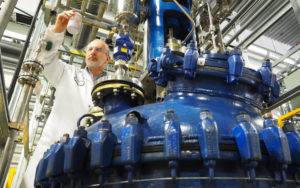The BASF partnership, coupled with the acquisition of one of North America’s only lithium-iron phosphate (LFP) battery materials facilities, helps move Nano One closer to its goal of becoming a low-cost producer of high performance cathode powders for use in lithium-ion batteries

Nano One, a Burnaby-headquartered battery technology company, made sister announcements last month that could have interesting implications for Canada’s electric vehicle battery supply chain. Photo: Nano One
The BASF partnership, coupled with the acquisition of one of North America’s only lithium-iron phosphate (LFP) battery materials facilities, helps move Nano One closer to its goal of becoming a low-cost producer of high performance cathode powders for use in lithium-ion batteries
Nano One, a Burnaby-headquartered battery technology company, made sister announcements last month that could have interesting implications for Canada’s electric vehicle battery supply chain.
On May 25, Nano One announced that for $10.25 million they take over by the end of 2022 Johnson Matthey Battery Materials (JMBM) — a Quebec lithium-iron phosphate cathode active material maker that supplies the lithium-ion battery market, including tier 1 automakers.
Nano One was originally formed in 2011 under the name Perfect Lithium and started trading publicly as Nano One in 2015. The company and JMBM had been working together in a joint development agreement since June 2021 for “nickel-rich advanced cathode materials.”

“The rapidly expanding need for responsibly produced cathode materials in North America presents an opportunity for Nano One to deploy its technology and become a leader. We are excited to announce our agreement to acquire JMBM Canada,” said Nano One CEO Dan Blondal, in a press release.
“The facility is in Greater Montreal and strategically located in proximity to employees and their families, international airports, major port facilities and is a critical link in the mines-to-mobility initiative.”
Following the acquisition, Nano One released news of a second major initiative on May 31: a joint venture with BASF SE, a global chemical giant (and supplier to, among other industries, battery manufacturers) that will see the two companies “co-develop a process with reduced by-products for commercial production of next-generation cathode active materials” according to the press release.
For its part, BASF previously announced it would be acquiring a site in Quebec to build its own cathode active materials plant. BASF said at the time the factory would be operational by 2025, but has not released further details.
Industry implications
The production of cathode active material (CAM) remains a yawning hole in Canada’s EV battery supply chain.
In 2022 General Motors and Posco Chemicals entered into a joint venture to build an Ultium CAM facility near Trois-Rivières in Quebec. But that facility, it seems, will only supply GM’s North American EV battery manufacturing plants.
While Nano One and BASF have yet to disclose which company or companies they will be producing CAM for, the technology application appears to be agnostic for lithium-ion batteries.
“The Candiac production facility was acquired by Johnson Matthey in 2015 and has been in operation since 2012. It is a supplier of lithium iron phosphate (LFP) cathode material to the lithium-ion battery sector for both automotive and non-automotive applications for a select group of customers,” reads the JMBM website.
The first public hint that big things were set to come from Nano One working on nickel-rich cathode material with JMBM (as well at manganese-rich cathode material) came in March 2022.
The company released a market outlook on the LFP potential, with Nano One COO Alex Holmes saying in a press release, “LFP batteries do not require any nickel or cobalt, which are recently very volatile and severely supply constrained. LFP is also the safest, longest lasting and most affordable lithium ion battery chemistry, making it perfect for mass market and industrial applications, leaving nickel and cobalt rich chemistries for high-margin long-range vehicles and consumer electronics.”
Nano One leaned on a Bloomberg Finance report that estimates, “global LFP demand will grow from 81 GWh in 2021 to 633 GWh by 2030 and 1070 GWh by 2035. This represents about 1300% growth and 22% of the total cathode active materials market for stationary storage, passenger EV, commercial EV, e-bus, and two/three wheeler applications, and an addressable market measured in tens of billions of dollars.”
If Nano One is able to scale at its projected rate, it could establish itself as one of the few high volume cathode suppliers outside of China. The company itself has pointed to supplying both the North American and European market as a long-term goal.
A more environmentally friendly battery?
One of the cornerstones of Nano One’s business plan is offering battery technology that is low carbon intensity and low cost.
The company’s innovation facilities (including its lab and pilot centre) are in British Columbia. Nano One’s new Quebec plant will be its first dedicated manufacturing facility.
Nano One has been developing in Burnaby and now putting into practice its “One Pot Process” for making cathode material.
The company describes the process as combining “the precursor cathode powder and coating stages into a ‘one-pot process.’ This process enables simpler feedstocks, reduces process steps, eliminates waste and enables longer lasting cathode materials.”
Nano One claims its cathode making process not only has a lower carbon footprint than the standard market approach, but produces a better quality product for less (cathode active material makes up roughly 25 per cent of the cost of a battery).
The technology “could make Québec and Canada world leaders once again in LFP and other types of cathode materials,” said Denis Geoffroy, commercialization lead for Nano One.
To achieve it mission, Nano One is currently seeking public funding from the government of Quebec and the federal government “to support our commercialization and scale-up.” In the last fiscal year Nano One received over $2 million in public monies.












